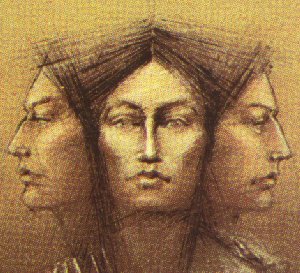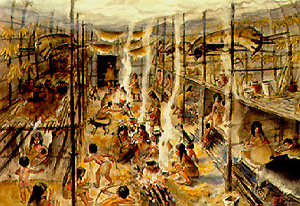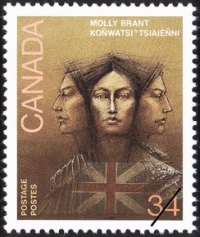Iroquois Woman
 In the Iroquois community, women were the keepers of culture. They were responsible for defining the political, social, spiritual and economic norms of the tribe. Iroquois society was matrilineal, meaning descent was traced through the mother rather than through the father, as it was in Colonial society. While Iroquois sachems (chiefs-leaders) were men, women nominated them for their leadership positions and made sure they fulfilled their responsibilities.
In the Iroquois community, women were the keepers of culture. They were responsible for defining the political, social, spiritual and economic norms of the tribe. Iroquois society was matrilineal, meaning descent was traced through the mother rather than through the father, as it was in Colonial society. While Iroquois sachems (chiefs-leaders) were men, women nominated them for their leadership positions and made sure they fulfilled their responsibilities.
Besides performing the normal household functions of producing, preserving and preparing  food and clothing for the family and taking care of the children, Iroquois women participated in many activities commonly reserved for men. They gambled, they belonged to Medicine Societies (spiritual associations) and they participated in political ceremonies.
food and clothing for the family and taking care of the children, Iroquois women participated in many activities commonly reserved for men. They gambled, they belonged to Medicine Societies (spiritual associations) and they participated in political ceremonies.
The Iroquois were an agricultural people and it was the women who owned the land and tended the crops. After marriage, an Iroquois man moved into the longhouse of his wife's family. Their children then became members of her clan.
Iroquois women had great influence in their communities and women such as Molly Brant became great leaders in their own right. While Iroquois society was far from being a female dominated matriarchy, Iroquois women enjoyed social equality and respect that was not shared by colonial women.
Honouring Molly Brant
1986 34¢ stamp: "Molly Brant, Koñwatsi'tsiaiéñni"
This stamp was designed by Sara Tyson.
Background: Molly Brant, known to the Iroquois as Koñwatsi'tsiaiéñni, was the undisputed leader of the Six Nations Matrons, an influential group of Iroquois women. She was a fervent Loyalist and the wife of Sir William Johnson, Superintendent of Indian Affairs in the Thirteen Colonies. Furthermore, she was the older sister of Joseph Brant; both of them were influential Loyalists during the 1776 American Revolution.
When the Revolution began, most of the Six Nations were pledged to neutrality. Molly and Joseph Brant encouraged them to break their treaties of neutrality with the Americans, and were ultimately successful in keeping four out of six loyal to the Crown. Throughout the early part of the war, Molly helped to shelter and feed Loyalists; she was also responsible for sending arms and munitions to those who were fighting for the King. She even passed information to the British in advance of the Battle of Oriskany, allowing them to route American forces in 1777.
Toward the end of the American Revolution, after they had lost lands to the Americans, many of the Iroquois fled west into the Cayuga Nation, and ultimately to Canada. Molly Brant used her influence with the British leaders to obtain new lands for the Loyalist Amerindians. Her reward for her heroism, from the British government, was a pension and a house in Kingston, Ontario.
Sara Tyson's design depicts three facets of the heroine's life: Molly Brant as Iroquois, Loyalist, and European.
Canada Post Corporation. [Postage Stamp Press Release], 1986.
Return to Top / Angelique Home Page / Home Page
Page refreshed : 9th January 2017
